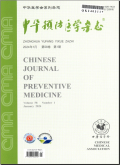深圳市空气中PM2.5与医院呼吸系统疾病门诊日就诊人次的关系研究
Impact of PM2.5 on daily outpatient numbers for respiratory diseases in Shenzhen, China
摘要目的:探讨深圳市空气PM2.5浓度与医院呼吸系统疾病门诊日就诊人次的关系。方法收集深圳市3家三级甲等综合性医院2013年1月1日至12月31日门诊的逐日电子就诊资料,按国际疾病分类标准第10版(IDC-10)将诊断疾病进行分类、筛选,汇总成每天每种疾病的就诊人次,排除诊断为流感病例的患者,最后将疾病编码为J00-J99者纳入作为研究对象,同时收集同时期深圳市环境监测站的逐日空气污染物数据和深圳市气象中心的气象因素数据。采用时间序列的半参数广义相加模型,在控制了长期趋势、季节趋势、星期几效应、节假日效应、流感及气象因素的影响后,分析2013年深圳市空气细颗粒物PM2.5日均浓度与医院呼吸系统疾病门诊日就诊人次的关系和滞后效应。结果2013年深圳市3家医院呼吸系统疾病门诊就诊量共1428672人次,平均为3914.17人次/d,最小值~最大值为1790~5228人次/d。2013年深圳市PM2.5年平均浓度为40.2μg/m3,PM2.5日平均浓度最小值~最大值为7.2~137.1μg/m3。PM2.5浓度对医院呼吸系统疾病门诊日就诊人次的影响存在滞后效应,滞后1 d时,PM2.5浓度每升高10μg/m3,呼吸系统疾病门诊日就诊人次的超额危险度(ER)为1.809%(95%CI:1.709%~1.909%)。控制其他污染物(NO2、CO、O3)后该效应保持稳定。分别控制NO2、CO、O3后,PM2.5浓度每升高10μg/m3,呼吸系统疾病门诊日就诊人次的ER分别为1.814%(95%CI:1.706%~1.923%)、2.780%(95%CI:2.668%~2.892%)、1.513%(95%CI:1.402%~1.624%);同时控制NO2、O3,同时控制NO2、CO和同时控制CO、O3后,PM2.5浓度每升高10μg/m3,呼吸系统疾病门诊日就诊人次的ER分别为1.369%(95%CI:1.242%~1.497%)、2.709%(95%CI:2.590%~2.828%)和2.577%(95%CI:2.452%~2.702%);同时控制NO2、CO、O3后,PM2.5浓度每升高10μg/m3,呼吸系统疾病门诊日就诊人次的ER为2.370%(95%CI:2.231%~2.509%)。结论深圳市PM2.5浓度升高能增加呼吸系统疾病门诊的日就诊量。
更多相关知识
abstractsObjective To assess the association between the concentration of the air pollutant PM2.5 and daily outpatient visits for respiratory disease. Methods All records of daily outpatient visits to three hospitals in Shenzhen from January 1 to December 31, 2013 were collected. Daily air pollution monitoring and meteorology data from the same period were also collected in Shenzhen. The data were analyzed using a semiparametric generalized additive model with Poisson distribution of time series analysis controlling for long-term and seasonal trends, flu, DOW, public holidays, and meteorological factors. The excess risk (ER) of respiratory disease and its 95%CI value were calculated, along with the incremental increase of 10 μg/m3 in PM2.5 concentration. Results Number of outpatient visits for respiratory diseases totaled 1 428 672 (daily range:1 790-5 228). The annual average PM2.5 concentration was 40.2μg/m3 (daily range:7.2-137.1μg/m3). The lag1 factor had the most significant impact on the lag effect. We estimated that a 10 μg/m3 increase in day-before PM2.5 concentration was associated with a 1.809% (95% CI:1.709%-1.909%) ER of visits for respiratory disease. After controlling for other pollutants (NO2, CO, and O3), the effect remained stable. When NO2, CO, and O3 were introduced separately, for every 10μg/m3 rise in PM2.5 concentration, the excess risk of daily outpatient visits for respiratory disease was 1.814% (95% CI:1.706%-1.923%), 2.780% (95% CI: 2.668%-2.892%), and 1.513% (95% CI: 1.403%-1.624%), respectively. With simultaneous control of NO2 and O3, NO2 and CO, and CO and O3, for every 10μg/m3 rise in PM2.5 concentration, the excess risk of respiratory disease was 1.369% (95% CI: 1.242%-1.497%), 2.709% (95% CI: 2.590%- 2.828% ), and 2.577% (95% CI: 2.452%- 2.702% ), respectively. With simultaneous control of NO2, CO, and O3, for every 10μg/m3 rise in PM2.5 concentration, the excess risk of respiratory disease was 2.370% (95% CI: 2.231%-2.509%). Conclusions PM2.5 can increase the risk of outpatient visits for respiratory disease in Shenzhen.
More相关知识
- 浏览423
- 被引22
- 下载228


相似文献
- 中文期刊
- 外文期刊
- 学位论文
- 会议论文



 换一批
换一批 换一批
换一批



